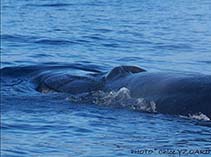Balaenoptera brydei Olsen, 1913
Bryde's whale| Native range | All suitable habitat | Point map | Year 2050 |

|
| This map was computer-generated and has not yet been reviewed. |
| Balaenoptera brydei AquaMaps Data sources: GBIF OBIS |
Classification / Names Populärnamn | synonymer | CoL | ITIS | WoRMS
Mammalia | Cetartiodactyla | Balaenopteridae
Environment: milieu / climate zone / djupintervall / distribution range Ekologi
; djupintervall 300 - 700 m (Ref. 116491). Tropical; 90°N - 90°S, 180°W - 180°E
Distribution Länder | FAO områden | Ekosystem | Förekomster | Utplanteringar
Indo-Pacific, Atlantic Ocean, and the Mediterranean. Tropical to temperate climates.
Length at first maturity / Size / Weight / Age
Könsmognad: Lm ? range ? - ? cm Max length : 1,460 cm TL hane/ej könsbestämd; (Ref. 1522); 1560 cm TL (female); rapporterad maxålder: 60 år (Ref. 79555)
Life cycle and mating behavior Könsmognad | Reproduktion | Lek | Eggs | Fecundity | Larvae
Main reference
referenser | Koordinator | Medarbetare
Rice, D.W. 1998 Marine Mammals of the World Systematics and Distribution. Special Publication number 4: The Society for Marine Mammalogy. 231p. (Ref. 1522)
IUCN Red List Status
(Ref. 130435: Version 2025-1)
CITES status (Ref. 108899)
CMS (Ref. 116361)
Threat to humans
Human uses
Fiskeri: kommersiell
| FishSource | Sea Around Us
Verktyg
Ytterligare information
Max. ages / sizes
Length-weight rel.
Length-length rel.
Length-frequencies
Mass conversion
Abundans
Könsmognad
Fecundity
Lek
Eggs
Egg development
Larvae
Internet-källor
BHL | BOLD Systems | CISTI | DiscoverLife | FAO(Publication : search) | Fishipedia | GenBank (genome, nucleotide) | GloBI | Gomexsi | Google Books | Google Scholar | Google | PubMed | Tree of Life | Wikipedia (Go, sök) | Zoological Record



